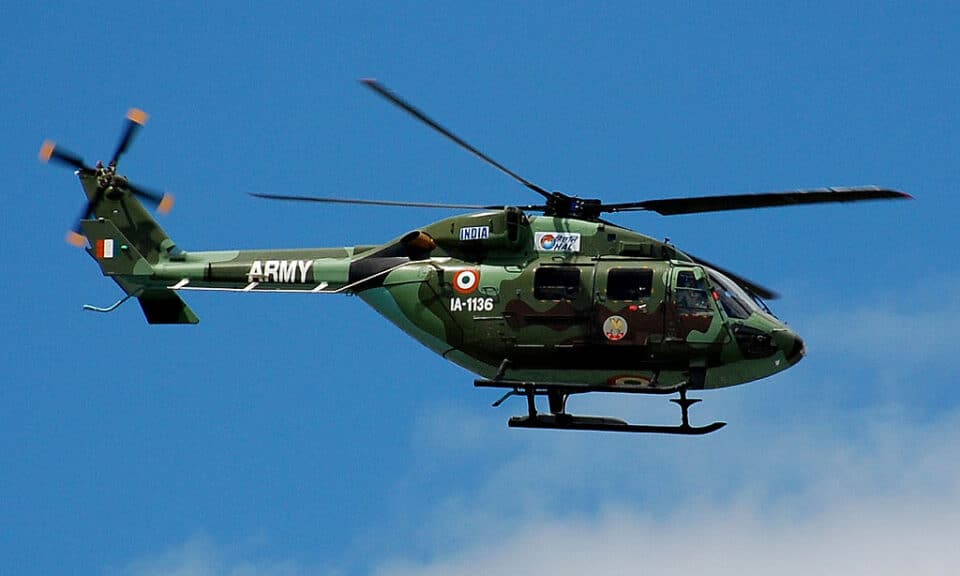Aerospace
HAL Dhruv received restricted-type certification from EASA

Hindustan Aeronautics Limited (HAL) has achieved restricted type certification for its indigenously developed helicopter platform, the HAL Dhruv, from the European Union Aviation Safety Agency (EASA) in Brussels, Belgium. This historic achievement validates HAL’s capacity to design and manufacture helicopters that meet the stringent certification requirements set by the European aviation regulatory authorities.
The EASA certification demonstrates HAL’s extraordinary engineering ability and perseverance in designing the Dhruv helicopter platform. It certifies that HAL has met and exceeded the European aviation industry’s strict safety, performance, and operational requirements.
How do the LCH and Dhruv Helicopter Surveillance Cameras function?(Opens in a new browser tab)
HAL has proven its dedication to upholding the highest standards of safety and quality in its aircraft designs by complying to the stringent European certification requirements. The EASA certification system involves a thorough assessment of a number of aspects, including design, manufacture, maintenance, and operational procedures, to make sure that the certified aircraft meet or surpass the established criteria.
The HAL Dhruv, renowned for its strong performance and adaptability, has already demonstrated its endurance in a variety of difficult circumstances, including military operations, search and rescue missions, disaster relief operations, and the transportation of personnel and cargo. Dhruv now has formal confirmation that it complies with European aviation standards by the EASA certification, which increases its trustworthiness and appeal to consumers.
Boeing-built X-37B came back to Earth after 908 days in space.(Opens in a new browser tab)
The EASA certification will help HAL build closer relationships with European aviation stakeholders as it widens its presence there, boosting partnerships and joint ventures. Potential consumers in the area are more confident as a result of the EASA’s recognition of the HAL Dhruv’s high quality and dependability.
The Hindustan-228 STOL twin-turboprop commuter aircraft and the civilian derived of the single-engined Light Utility Helicopter (LUH), which is currently being constructed in series at the greenfield HAL facility in Tumakuru, are now poised to receive similar airworthiness type-certification from HAL.

Aerospace
Boeing Transfers Rocket Stage to NASA, Paving Way for Human Moon Mission

Boeing has achieved a significant milestone by providing NASA with the second core stage of the Space Launch System (SLS) rocket.
This crucial component, crafted at NASA’s Michoud Assembly Facility (MAF), is set to propel the Artemis II crew into lunar orbit, marking humanity’s return to deep space after a 50-year hiatus.
The monumental Boeing-built rocket stage, the largest element of the Artemis II mission, will embark on a journey aboard the Pegasus barge, traveling 900 miles to NASA’s Kennedy Space Center.
Comparison of two legendary aircraft B777x vs B747 aircraft:Click here
Upon arrival, it will be meticulously integrated with other essential Artemis II components, including the upper stage, solid rocket boosters, and NASA’s Orion spacecraft within the iconic Vehicle Assembly Building. This intricate integration process is a vital step toward the eagerly anticipated Artemis II launch, slated for 2025.
“Boeing-built products helped land humankind on the moon in 1969, and we’re proud to continue that legacy through the Artemis generation,” remarked Dave Dutcher, vice president and program manager for Boeing’s SLS program. “Together, with NASA and our industry partners and suppliers, we are building the world’s most capable rocket and paving the way to deep space through America’s rocket factory in New Orleans.”
NASA, Lockheed Martin Reveal X-59 Quiet Supersonic Aircraft:Click here
The delivery of Core Stage 2 marks a significant achievement in the evolution of the SLS rocket. Towering over 200 feet and powered by four RS-25 engines, this core stage, coupled with two solid-fueled booster rockets, will generate a staggering 8.8 million pounds of thrust. This immense power is crucial to launching Artemis II and future missions into the vast expanse of space.
The SLS rocket stands unparalleled in its capability to transport both crew and substantial cargo to the moon and beyond in a single launch. Its extraordinary capacity will facilitate the delivery of human-rated spacecraft, habitats, and scientific missions to destinations including the moon and Mars, ushering in a new era of space exploration.
-

 Travel1 week ago
Travel1 week agoAir India to Expand US Operations with Three New Routes After a Decade
-

 Travel2 weeks ago
Travel2 weeks agoWhy We Should Avoid These Stamps in a Passport
-

 Airlines1 month ago
Airlines1 month agoInvestigations Reveal Fake Chinese Titanium in Boeing and Airbus Jets
-

 Tech4 weeks ago
Tech4 weeks agoChina’s CATL Plans 1,800-Mile Electric Plane Launch by 2027
-

 Airport3 days ago
Airport3 days agoTop 10 Largest Airports in the World by Size
-

 Aerospace4 weeks ago
Aerospace4 weeks agoChina’s Fighter Jets Turn Wings into Autonomous Drones
-

 Airlines4 days ago
Airlines4 days agoAir India Rolls Out A350s for Delhi-New York JFK and Newark Routes
-

 Defence3 weeks ago
Defence3 weeks agoBoeing Enhances Chinook with New Engines and Block II Upgrades at $96 Million







